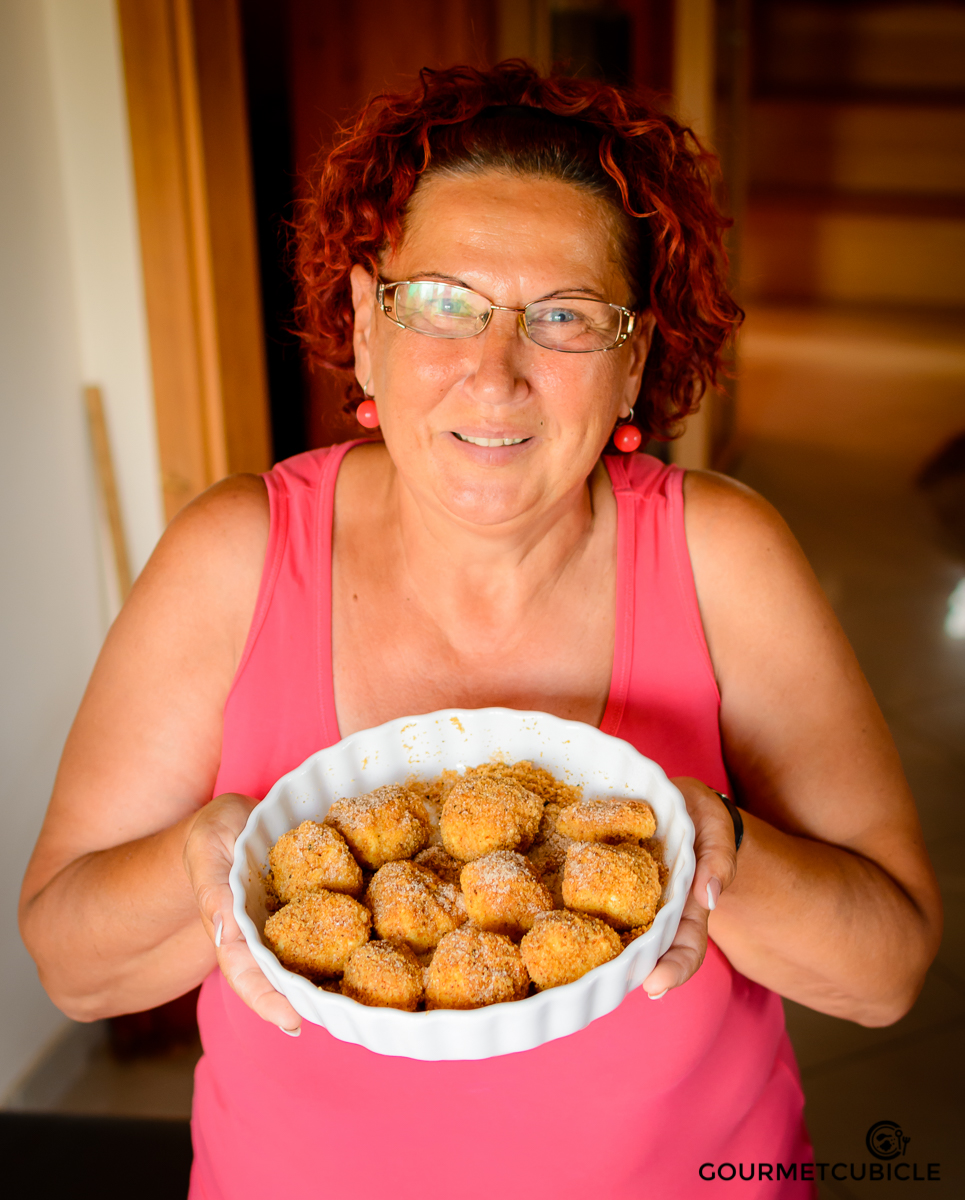Homemade Tagliatelle Cacio e Pepe with Brussels Sprouts
I know a lot of people get nervous when it comes to making homemade pasta, but I've never been intimidated by it. This may come off as cocky, but believe me, it's actually quite simple to make pasta. It consists of four basic ingredients: flour, eggs, olive oil (or water) and salt. Nothing else. It's not like baking or bread making where you have to be super precise, pay attention to the hydration of the dough and all that jazz.
Making pasta was one of my favorite pastimes with my Hungarian grandmother Jolika. She made pasta quite often (that was the only option during the communist regime, as the stores didn't sell such things). Most of the times she made either a traditional Hungarian type of pasta stuffed with prune preserves called derelye (coming soon, I promise) or a thinner variation of the well-known angel hair pasta which she used in her homemade chicken noodle soup. The process is the same as with any other type of pasta. It doesn't matter if you're making tagliatelle, spaghetti, ravioli or linguini you will have to knead, rest, roll, cut and dry the pasta. Five steps and you're done.
Preparing homemade pasta from scratch can be time consuming and exhausting. Nowadays though the process is overly simplified by all the available tools and gadget. Kitchen mixers and pasta machines can be found in a lot of households, but even if you don't have any of these tools, you can still make it happen the old school way. I don't own a mixer, so I have to knead the dough by hand which I actually like doing even though it can be tough on your arms. It gives me a better feel for the consistency of the dough which lets me adjust it by adding water or an extra egg when too dry, or flour when too wet.
When Jolika used to make it, she had to roll out the dough with a rolling pin and then cut it with a very sharp knife. I mentioned in one of my previous posts that whenever she was making pasta she would give me a tiny piece of dough to practice rolling with my own mini rolling pin. It actually helped me a lot, as I still remember what the right consistency for the dough needs to be. Another important thing that I learned from Jolika was to use the right type of flour. Even in Hungary, when making tészta (pasta), we always used nullás liszt "0" which, as you may already have guessed, is the "00" flour. One day I'll have a kid and I'll do the same thing as Jolika did when I was a child
The inspiration for this recipe came from an episode of Anthony Bourdain's No Reservation. It's the Sicily episode where he's going to this cute little trattoria and eats what "could be the greatest thing in the history of the world" according to him. When I heard this, I already knew what dinner was going to be the next day. I know that brussels sprouts aren't normally part of this dish, but they were in season and cheap when I came up with this recipe last fall, so I tossed them in. As for the lemon and sunflower seeds, I took a tip from a Bon Appétit Foodcast podcast (How to Make a Killer Summer Pasta episode) that suggested adding a bit of acid and nuts or seeds to elevate the taste of the pasta. Buon appetito!
HOMEMADE TAGLIATELLE CACIO E PEPE WITH BRUSSELS SPROUTS
Serves 2-4
Prep time: 60 minutes
Cook time: 30 minutes
Inactive time: 30 minutes
Ingredients
- 1/2 lb "00" flour
- 2 whole eggs, pasture raised
- 2 egg yolks, pasture raised
- 1/4 tsp salt
- 1 TBS olive oil, extra-virgin
- 1 TBS water (if needed)
- 1/2 cup "00" flour, for kneading and rolling
- 1 1/2 TBS salt, for boiling the pasta
- 2 TBS butter, unsalted
- 2 thai chilis
- 2 cloves garlic, crushed and finely chopped
- 1 lb brussels sprouts, cleaned and halved
- 1 TBS olive oil, extra-virgin
- 1 TBS black pepper, freshly ground
- 1 cup Pecorino Romano (or Parmigiano-Reggiano), freshly grated
- 1/4 cup sunflower seeds, toasted
- 1/2 lemon
Instructions
- Start with the pasta. In the center of your work station (preferably a large wooden cutting board) heap up a half pound of flour. Keep the rest nearby. Make a “well" in the center and pour in the eggs and the yolks. Add salt and one tablespoon olive oil and beat the mixture lightly with a fork. Using your fingertips, gradually start incorporating the flour into the egg mixture. Gradually work the dough together until all the flour is mixed in. The dough should be sticky and it should hold together. Depending on the size of the eggs, you may need to hydrate your dough if it is too dry by adding one tablespoon of water.
- Knead the dough using the palms of your hand, until the dough becomes smooth and elastic, about 5 minutes. Make a ball out of the dough, sprinkle flour, wrap ball in plastic, and let it rest in the refrigerator for at least half an hour.
- Remove the dough from the refrigerator and divide it in 5-6 equal parts. Slightly drizzle water over a kitchen towel and cover the 5-6 small dough pieces. You will work with one at a time, so the damp towel will keep them from drying out.
- Take the first piece of dough, flatten it with your hands so that it is 1-inch thick and sprinkle with a little flour on both sides. Using a pasta maker, roll out the dough. Start with the thickest setting and work your way to the desired thickness. For tagliatelle I usually stop at the 5 setting.
- To stretch the pasta into a sheet, roll it through the pasta maker on the rest of the settings, going down one level at a time, rolling it through about 2 or 3 times on each level. The more you run it through the machine, the silkier your pasta will be. If the dough starts sticking at any point, sprinkle some flour on it.
- To cut the noodles, run your pasta sheet through whichever cutting attachment you prefer, running it through in the same way as when you stretched out the sheets.
- Once the noodles are cut, hang them to dry over a pasta hanger or place them on parchment paper and sprinkle with flour.
- Bring a large pot of generously salted water (one and a half tablespoons of salt) to a boil.
- While the water is getting hot, heat butter in a deep skillet over medium-high heat. When the butter is melted and starts foaming, add chilis and garlic. Stir and cook for 2-3 minutes. Add brussels sprouts and cook for 10-15 minutes, stirring occasionally. Transfer the brussels sprouts from the pan to a plate and set aside.
- In the same skillet that you used for the sprouts, heat one tablespoon of olive oil until it slides easily across the skillet. Toss in cracked pepper and roast for 2-3 minutes. Add the brussels sprouts back into the skillet and remove from the heat.
- When the water in the pot is boiling drop in tagliatelle and cook for 2-3 minutes at most. Fresh pasta takes a lot less time to cook. Save one cup of pasta water and then, drain the pasta using a colander. Shake off excess water and add pasta to the skillet with the brussels sprouts.
- Stir, add the pasta water and cook for about 2-3 more minutes until the pasta is al dente. Remove from heat and add the cheese.
- Toss well until pasta is evenly coated. Before serving, squeeze half a lemon all over the pasta and sprinkle toasted sunflower seeds on top.
Notes
- When using the pasta maker, run the dough through the largest setting at least 4-5 times, folding it in half after each roll.
- When making tagliatelle, I recommend that you don't go higher than setting number 5-6 on the machine as your pasta will be too thin and will break easily. Also the texture is not going to be the same.
- Make sure you don't burn the garlic as it will become bitter.




























